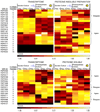Comparison of aerobic and photosynthetic Rhodobacter sphaeroides 2.4.1 proteomes
- PMID: 16828186
- PMCID: PMC2794424
- DOI: 10.1016/j.mimet.2006.04.021
Comparison of aerobic and photosynthetic Rhodobacter sphaeroides 2.4.1 proteomes
Abstract
The analysis of proteomes from aerobic and photosynthetic Rhodobacter sphaeroides 2.4.1 cell cultures by liquid chromatography-mass spectrometry yielded approximately 6,500 high confidence peptides representing 1,675 gene products (39% of the predicted proteins). The identified proteins corresponded primarily to open reading frames (ORFs) contained within the two chromosomal elements of this bacterium, but a significant number were also observed from ORFs associated with 5 naturally occurring plasmids. Using the accurate mass and time (AMT) tag approach, comparative studies showed that a number of proteins were uniquely detected within the photosynthetic cell culture. The estimated abundances of proteins observed in both aerobic respiratory and photosynthetic grown cultures were compared to provide insights into bioenergetic models for both modes of growth. Additional emphasis was placed on gene products annotated as hypothetical to gain information as to their potential roles within these two growth conditions. Where possible, transcriptome and proteome data for R. sphaeroides obtained under the same culture conditions were also compared.
Figures




Similar articles
-
Application of the accurate mass and time tag approach to the proteome analysis of sub-cellular fractions obtained from Rhodobacter sphaeroides 2.4.1. Aerobic and photosynthetic cell cultures.J Proteome Res. 2006 Aug;5(8):1940-7. doi: 10.1021/pr060050o. J Proteome Res. 2006. PMID: 16889416 Free PMC article.
-
Construction and validation of the Rhodobacter sphaeroides 2.4.1 DNA microarray: transcriptome flexibility at diverse growth modes.J Bacteriol. 2004 Jul;186(14):4748-58. doi: 10.1128/JB.186.14.4748-4758.2004. J Bacteriol. 2004. PMID: 15231807 Free PMC article.
-
Evidence for the role of redox carriers in photosynthesis gene expression and carotenoid biosynthesis in Rhodobacter sphaeroides 2.4.1.J Bacteriol. 1997 Mar;179(6):1951-61. doi: 10.1128/jb.179.6.1951-1961.1997. J Bacteriol. 1997. PMID: 9068641 Free PMC article.
-
The photosynthetic membrane proteome of Rhodobacter sphaeroides R-26.1 exposed to cobalt.Res Microbiol. 2011 Jun;162(5):520-7. doi: 10.1016/j.resmic.2011.04.008. Epub 2011 Apr 22. Res Microbiol. 2011. PMID: 21515364
-
Proteomic characterization of the Rhodobacter sphaeroides 2.4.1 photosynthetic membrane: identification of new proteins.J Bacteriol. 2007 Oct;189(20):7464-74. doi: 10.1128/JB.00946-07. Epub 2007 Aug 17. J Bacteriol. 2007. PMID: 17704227 Free PMC article.
Cited by
-
Application of the accurate mass and time tag approach to the proteome analysis of sub-cellular fractions obtained from Rhodobacter sphaeroides 2.4.1. Aerobic and photosynthetic cell cultures.J Proteome Res. 2006 Aug;5(8):1940-7. doi: 10.1021/pr060050o. J Proteome Res. 2006. PMID: 16889416 Free PMC article.
-
Role of the global transcriptional regulator PrrA in Rhodobacter sphaeroides 2.4.1: combined transcriptome and proteome analysis.J Bacteriol. 2008 Jul;190(14):4831-48. doi: 10.1128/JB.00301-08. Epub 2008 May 16. J Bacteriol. 2008. PMID: 18487335 Free PMC article.
-
Transcriptomic analysis of aerobic respiratory and anaerobic photosynthetic states in Rhodobacter capsulatus and their modulation by global redox regulators RegA, FnrL and CrtJ.Microb Genom. 2017 Jul 8;3(9):e000125. doi: 10.1099/mgen.0.000125. eCollection 2017 Sep. Microb Genom. 2017. PMID: 29114403 Free PMC article.
-
Loss of the response regulator CtrA causes pleiotropic effects on gene expression but does not affect growth phase regulation in Rhodobacter capsulatus.J Bacteriol. 2010 Jun;192(11):2701-10. doi: 10.1128/JB.00160-10. Epub 2010 Apr 2. J Bacteriol. 2010. PMID: 20363938 Free PMC article.
-
Comparative Proteomic Analysis of Desulfotomaculum reducens MI-1: Insights into the Metabolic Versatility of a Gram-Positive Sulfate- and Metal-Reducing Bacterium.Front Microbiol. 2016 Feb 19;7:191. doi: 10.3389/fmicb.2016.00191. eCollection 2016. Front Microbiol. 2016. PMID: 26925055 Free PMC article.
References
-
- Anderson KK, Monroe ME, Daly DS. Estimating probabilities of peptide assignments to LC-FTICR-MS observations. Proc of the Intern Conf METMBS. 2004:151–156.
-
- Armitage JP, Schmitt R. Bacterial chemotaxis: Rhodobacter sphaeroides and Sinorhizobium meliloti — variations on a theme? Microbiology. 1997;143:3671–3682. - PubMed
-
- Belov ME, Anderson GA, Wingerd MA, Udseth HR, Tang KQ, Prior DC, Swanson KR, Buschbach MA, Strittmatter EF, Moore RJ, Smith RD. An automated high performance capillary liquid chromatography-Fourier transform ion cyclotron resonancemass spectrometer for high-throughput proteomics. J. Am. Soc. Mass Spectrom. 2004;15:212–232. - PubMed
Publication types
MeSH terms
Substances
Grants and funding
LinkOut - more resources
Full Text Sources

